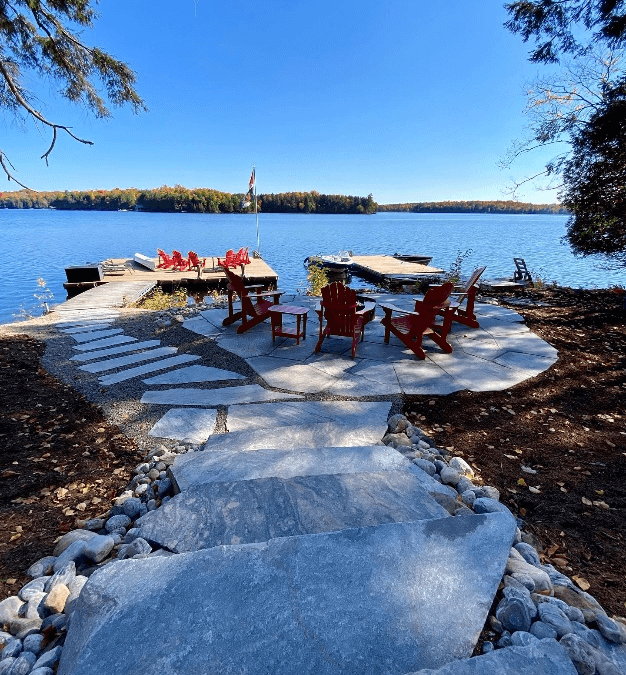In landscaping, “hardscape” refers to anything that isn’t alive, such as bricks, stone walls, or wooden arbours. In landscaping, hardscape and softscape form the two major subcategories. Plants, trees, flowers, and grass are all examples of softscape, which include all of the living elements of a garden or lawn. Decorative or functional structures can be incorporated into a landscape as hardscaping, such as driveways, fences, and benches. Natural areas and features are defined and organized with hardscape, making them an integral element of landscape design.
Importance of Hardscape
We spend much of our time at home resting, laughing, and being leisurely. A home is a gathering place for family and friends, a place we build so passionately. The most important thing about our homes is that they reflect who we are.
Homeowners spend nearly ten percent of their home’s value upgrading or renovating their hardscaping. There’s a good reason for that! You can raise the value of your property by adding these outdoor additions that are both functional and aesthetic.
There are endless possibilities when it comes to hardscaping. An elegant patio, an outdoor kitchen, a stone fence, or a walkway with the perfect paver pattern are all possible with a hardscaping design. A hardscape doesn’t need to be a series of hard design decisions or either-or choices.
Things You Should Know Before Hardscaping
There is no shortage of ideas and excitement when it comes to starting a new hardscaping project, considering your front and backyard to be blank canvases. If you want your hardscape plan to be executed properly, you do not need to hire an expert landscaper or an outside contractor. However, you do not want to overcomplicate the process, which will stifle your creative spirit.
Something essential to consider here is that a well-designed hardscape for your home can boost its value, especially if you’re planning to sell. The following are important steps to consider before starting the project:
1. Conduct Site Analysis
Perform a thorough and detailed analysis of your property’s natural features before doing anything else. During a comprehensive site analysis, natural hills and slopes, soil type, rocks and other heavy impediments such as foliage, water and drainage should be assessed, as well as maintenance requirements.
Keeping all this in mind will help you determine the dimensions of your upcoming installation. Hardscapes shouldn’t occupy too much space. It’s better to leave patches untouched for a more natural look.
Next, determine if the hardscaping vision you have aligns with the practicalities of your terrain. The purpose of your project is to make your yard look its best by showing off its physical assets. Enhance what you have already done by making smart choices.
2. Set the Budget
A hardscaping project’s price is determined by several variables. It will be easier for you to manage and execute your project if you estimate it at an earlier stage.
As part of your hardscaping budget, you should include:
- Raw and manufactured materials required for hardscaping.
- Costs associated with Hardscape landscaping manipulations, such as redirecting drainage or obtaining permits.
- Softscapes, flowers, plantings, benches, fencing, and other decorative yard items.
- Purchased or rented tools.
- Professional help, if hired.
The cost can vary based on what elements you decide to go with. Residential areas and the cost of materials at a certain time can also be a huge factor. You should never deviate from personal comfort when planning your hardscaping project budget.
3. Research Area & Building Regulations
Check hardscaping codes, building regulations, zoning laws, and any permits required by your municipality before starting your project. The easiest way to do this is to search your city’s name online and then select “residential ordinances.” You can also contact your local ordinance board with any questions you may have.
Prior to beginning your project, find out whether your neighbourhood requires an on-site inspection by the municipality. In the absence of a permit, you could be fined or have your hardscaping stopped – or worse, you might be forced to remove everything you have already invested time and money into.
4. Review Samples of Tools & Materials
For your hardscape design to be completed, you’ll probably need a few conventional materials and resources, hence it’s better to review them in advance based on samples. You can stay on track with your project timeline and budget by considering tools and materials beforehand. Among the most commonly used hardscape materials are concrete, brick, wood, and stone.
Working on Hardscape Projects
The installation of hardscaping can be a very tedious process. There is no doubt that these projects are tough, even under the best weather, budget, and land conditions. Spring and fall is the best time period to go ahead and execute your hardscaping projects.
There are certain hardscape projects that are too physically demanding for manual labour alone, and there are others that require heavy machinery. Renting heavy equipment could be the answer to your problem if you can’t afford to purchase it. You can find life-saving equipment at rental stores if you’re doing it yourself.
Bottom Line
Your backyard can be used for a variety of activities depending on what types of hardscapes you choose. Create a little community area with specific chairs that match your aesthetic, a fire pit in the middle, and chairs around it, and you will open the door for people to join together and share an experience.
Depending on your landscape design goals, you can create hardscapes that complement your house and reflect who you are with a great landscaper.
As far as a business environment is concerned, a bench, a fountain, or even bird feeders can signal what kind of business you are and what kind of impression you want to leave on potential clients. No matter what your requirements are, knowledgeable professionals at Schlager Excavating & Landscaping can help you with landscaping in Muskoka.

